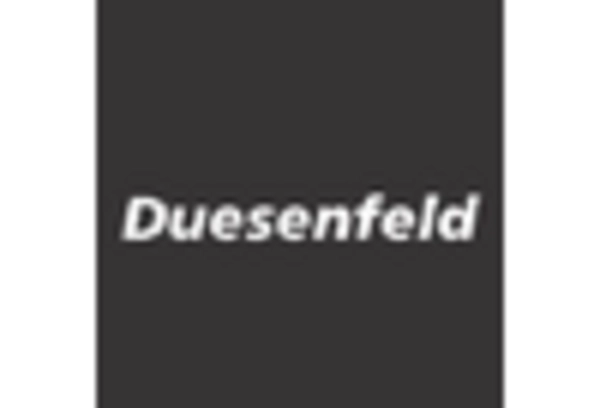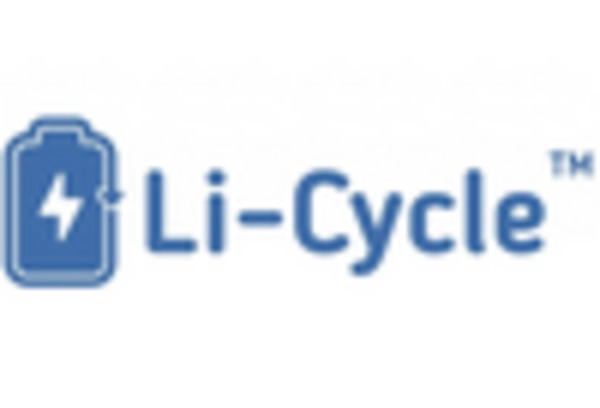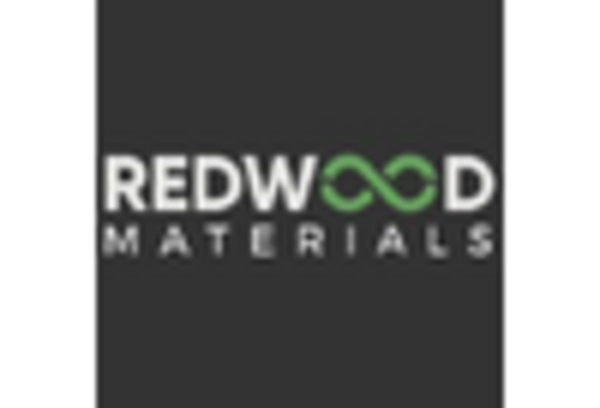Government Incentives and Policies
Government initiatives in North America are increasingly focusing on promoting sustainable practices, which directly impacts the li ion-battery-recycling market. Various states have introduced incentives for battery recycling programs, including tax breaks and grants for companies engaged in recycling operations. For instance, in 2025, funding for recycling initiatives is projected to reach $500 million, aimed at enhancing infrastructure and technology for battery recovery. These policies not only encourage manufacturers to adopt recycling practices but also raise public awareness about the importance of battery disposal. As regulations tighten around battery waste management, the li ion-battery-recycling market is likely to experience accelerated growth, driven by both compliance requirements and financial incentives.
Rising Demand for Electric Vehicles
The increasing adoption of electric vehicles (EVs) in North America is a pivotal driver for the li ion-battery-recycling market. As consumers and manufacturers shift towards sustainable transportation, the demand for lithium-ion batteries is surging. In 2025, it is estimated that the EV market will grow by approximately 30%, leading to a significant rise in battery waste. This trend necessitates efficient recycling solutions to manage the growing volume of spent batteries. The li ion-battery-recycling market is poised to benefit from this demand, as recycling not only recovers valuable materials but also reduces environmental impact. Furthermore, the transition to EVs aligns with governmental initiatives aimed at reducing carbon emissions, thereby reinforcing the need for robust recycling frameworks to support this burgeoning market.
Consumer Awareness and Environmental Concerns
Growing consumer awareness regarding environmental issues is significantly influencing the li ion-battery-recycling market. As individuals become more conscious of the ecological impact of battery waste, there is an increasing demand for responsible recycling solutions. Surveys indicate that over 70% of consumers in North America are willing to pay a premium for products that are sustainably sourced and recycled. This shift in consumer behavior is prompting manufacturers to adopt more sustainable practices, including the implementation of take-back programs for used batteries. The li ion-battery-recycling market is likely to benefit from this trend, as companies that prioritize sustainability may gain a competitive edge in the marketplace. Furthermore, educational campaigns aimed at informing the public about proper battery disposal methods are expected to enhance recycling rates.
Partnerships and Collaborations in the Industry
Strategic partnerships among stakeholders in the li ion-battery-recycling market are emerging as a crucial driver for growth. Collaborations between manufacturers, recyclers, and research institutions are fostering innovation and improving recycling efficiencies. For example, joint ventures aimed at developing new recycling technologies are becoming more common, allowing for shared resources and expertise. In 2025, it is anticipated that partnerships will lead to the establishment of at least 10 new recycling facilities across North America, significantly increasing capacity. These collaborations not only enhance operational capabilities but also facilitate knowledge transfer, which is essential for addressing the complexities of battery recycling. As the industry evolves, such partnerships are likely to play a vital role in shaping the future of the li ion-battery-recycling market.
Technological Advancements in Recycling Processes
Innovations in recycling technologies are transforming the li ion-battery-recycling market in North America. Advanced methods such as hydrometallurgical and pyrometallurgical processes are being developed to improve the efficiency of material recovery from spent batteries. These technologies can potentially increase recovery rates of critical materials like lithium, cobalt, and nickel by up to 90%. As these processes become more commercially viable, they are expected to attract investment and drive growth in the recycling sector. The integration of automation and artificial intelligence in recycling facilities further enhances operational efficiency, reducing costs and improving safety. Consequently, the li ion-battery-recycling market stands to gain from these technological advancements, which may lead to a more sustainable and economically viable recycling landscape.


















Leave a Comment